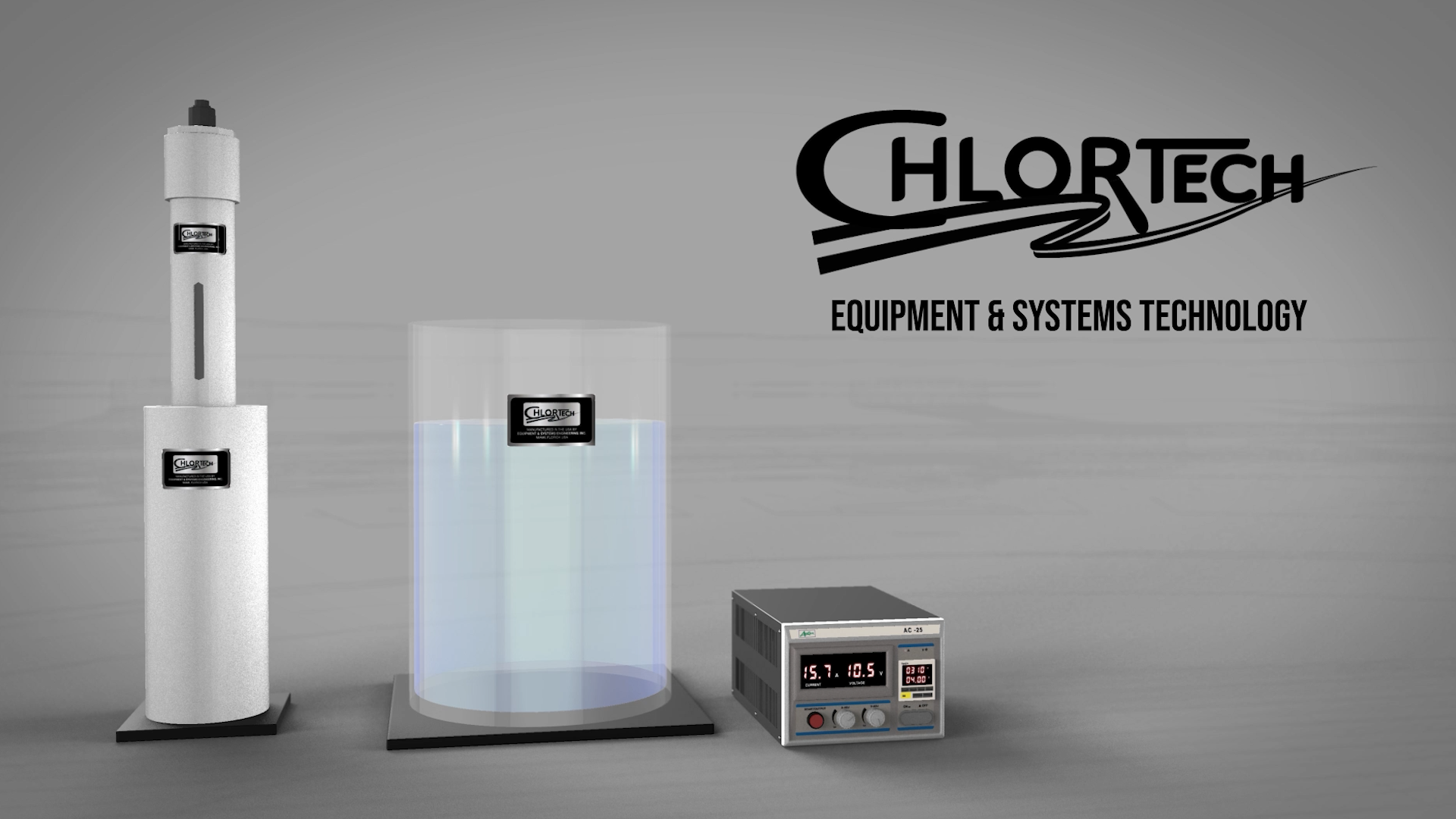How It Works
Theory of Chlorination and Operation
Sodium hypochlorite, “NaOCl” (also known as “hypo”, “bleach”, or “liquid chlorine”), is a powerful oxidant that is used world-wide for the disinfection of water through chlorination
Sodium Hypochlorite
How on-site sodium hypochlorite is produced?
Salt is composed of sodium and chloride. When in solution and electricity DC is passed through special electrodes, the chlorides will disassociate to form chlorine. The process is basically as follows:
- Electrolysis occurs in a cell when a DC current is passed through a saline water solution or brine.
- At the anode: Oxidation of chloride ions produce chlorine (Cl2).
- At the cathode: Reduction of water produce sodium hydroxide (NaOH) and hydrogen (H2).
Liberated chlorine reacts with the sodium hydroxide to generate sodium hypochlorite (NaOCl).
The overall reaction is as follows:
2NaCl (salt) + H2O (water) NaOCl (hypo) + NaCl (salt) + H2 (hydrogen)

Dosing of chlorine into the water
One liter of 0.6% (6000 ppm) sodium hypochlorite solution mixed into 6000 liters of water will produce a 1ppm concentration. Likewise, to produce a 2 ppm concentration, add 2 liters of 0.6% sodium hypochlorite solution to 6000 liters of water.
| TANK CAPACITY | DOSAGE OF THE SOLUTION OF NaOCl AT 0.6% CONCENTRATION | |||||||||
|---|---|---|---|---|---|---|---|---|---|---|
| 2 PPM | 3 PPM | 4 PPM | ||||||||
| Gals. | Liters. | Liters. | Gals. | Grams of Cl₂ | Liters. | Gals. | Grams of Cl₂ | Liters. | Gals. | Grams of Cl₂ |
| 1000 | 3785 | 1.3 | 0.33 | 7.57 | 1.9 | 0.5 | 11.36 | 2.5 | 0.67 | 15.14 |
| 5000 | 18927 | 6.3 | 1.67 | 37.85 | 9.5 | 2.5 | 56.78 | 12.6 | 3.33 | 75.71 |
| 6000 | 22712 | 7.6 | 2.0 | 45.42 | 11.4 | 3.0 | 68.14 | 15.1 | 4.0 | 90.85 |
| 7000 | 26498 | 8.8 | 2.33 | 53.0 | 13.2 | 3.5 | 79.49 | 17.7 | 4.67 | 105.99 |
| 8000 | 30283 | 10.1 | 2.67 | 60.57 | 15.1 | 4.0 | 90.85 | 20.2 | 5.33 | 121.13 |
| 9000 | 34069 | 11.4 | 3.0 | 68.14 | 17.0 | 4.5 | 102.21 | 22.7 | 6.0 | 136.27 |
| 10000 | 37854 | 12.6 | 3.33 | 75.71 | 18.9 | 5.0 | 113.56 | 25.2 | 6.77 | 151.42 |
Advantages of Electrochlorination
Raw material:
locally available (water + salt + electricity).
On-site:
generated at the point of use and application.
On demand:
only when required.
No bulk storage:
because is generated on demand.
Safe for the operator:
low concentration.
Safe for environment:
chlorine desomposes back into common salt.
Generate Sustainable Projects
Frequently Asked Questions
What is the concentration of the disinfectant produced?
The disinfectant produced will contain 6 grams of available equivalent chlorine per liter of solution. The concentration is 6000 parts per million or 6000 ml per lit
What is the expected lifetime of the system?
The electrodes are warranted for one year form the purchase date, but with proper care will last well beyond that time.
What maintenance is required?
Mineral deposits accumulate on the surface of the electrodes during normal operation. The rate of accumulation depends on the quality of the water used to produce the sodium hypochlorite. To remove the mineral deposits the electrode needs to be submerged in a weak acid solution or white vinegar.
How much disinfectant should I use for drinking water?
That depends on the amount of organic contaminants in the water. Typically you will want to dose enough disinfectant to neutralize all the organic material in the water and leave a residual of <0.6PPM of chlorine. A dose of 2 PPM is commonly used.
How efficient is the Sodium Hypochlorite solution compared to Gas Chlorine and Calcium Hypochlorite in the water disinfection?
The chlorine available for disinfection contained in gas chlorine, calcium hypochlorite and sodium hypochlorite is exactly the same and do the same work.
How complicated is to operate and maintain these units?
It is extremely easy to use and maintain. There aren't any specific required skills or prior knowledge to operate the equipment.
